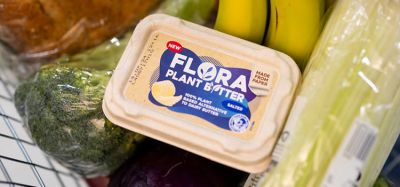LCMS as a reliable tool for monitoring food allergens contamination
- Like
- Digg
- Del
- Tumblr
- VKontakte
- Buffer
- Love This
- Odnoklassniki
- Meneame
- Blogger
- Amazon
- Yahoo Mail
- Gmail
- AOL
- Newsvine
- HackerNews
- Evernote
- MySpace
- Mail.ru
- Viadeo
- Line
- Comments
- Yummly
- SMS
- Viber
- Telegram
- Subscribe
- Skype
- Facebook Messenger
- Kakao
- LiveJournal
- Yammer
- Edgar
- Fintel
- Mix
- Instapaper
- Copy Link
Posted: 1 May 2012 | Linda Monaci, National Research Council of Italy (ISPA-CNR) | No comments yet
Food allergen research has considerably expanded its field of interest in recent years probably due to the increasing incidence of food allergies throughout the population. According to the last legislation issued on this issue, there is a current trend to develop reliable methods tailored to the detection of food allergens for routine-like applications. Lately, MS-based methodologies have attracted the interest of researchers owing to the great potentials offered by this technology, the ability to perform multi-allergen screening in food products. The MS approach is currently being adopted by the allergen detection community, proving to be a valid alternative to ELISA and PCR methods. MS methodologies applied to food allergen detection are herein presented. There has been an increasing interest in the field of food allergy in the last few decades probably due to the wide spread of this pathology throughout the population, especially affecting industrialised countries. A food allergy is defined as an abnormal immunological reaction (Ig-E and non-IgE-mediated) triggered by the ingestion of a food or food additive also known as ‘food allergen’. The mechanisms by which a person develops an allergy to specific foods are largely unknown. However, there is accumulated evidence that the early colonisation of the intestinal tract by an appropriate intestinal microbiota is important for the healthy maturation of the immune system with an appropriate programming of oral tolerance to dietary antigens. Whether an individual becomes sensitised or tolerant to an allergen depends on the timing and dose of the allergen as well as the route of exposure…


Food allergen research has considerably expanded its field of interest in recent years probably due to the increasing incidence of food allergies throughout the population.


According to the last legislation issued on this issue, there is a current trend to develop reliable methods tailored to the detection of food allergens for routine-like applications. Lately, MS-based methodologies have attracted the interest of researchers owing to the great potentials offered by this technology, the ability to perform multi-allergen screening in food products. The MS approach is currently being adopted by the allergen detection community, proving to be a valid alternative to ELISA and PCR methods. MS methodologies applied to food allergen detection are herein presented. There has been an increasing interest in the field of food allergy in the last few decades probably due to the wide spread of this pathology throughout the population, especially affecting industrialised countries.
A food allergy is defined as an abnormal immunological reaction (Ig-E and non-IgE-mediated) triggered by the ingestion of a food or food additive also known as ‘food allergen’1. The mechanisms by which a person develops an allergy to specific foods are largely unknown. However, there is accumu lated evidence that the early colonisation of the intestinal tract by an appropriate intestinal microbiota is important for the healthy maturation of the immune system with an appropriate programming of oral tolerance to dietary antigens2,3. Whether an individual becomes sensitised or tolerant to an allergen depends on the timing and dose of the allergen as well as the route of exposure.
Many other factors are also involved in triggering an immune response including allergen nature, genetic background and the environment at the time of the encounter4. In general, the ingestion of milligram quantities of an allergenic food can be problematic, but in some cases, smaller quantities can sometimes cause severe or even fatal reactions such as anaphylactic shock. Apart from geographic differences in the sensitisation pattern to individual allergens of one food, the lists of the most prevalent food elicitors capable of inducing allergic reactions in different geographic areas show important differences which may be most likely explained by different nutritional habits1. The true prevalence of adverse food reactions is still not defined. In general, food allergies are more prevalent in children than adults and a majority of affected children will outgrow food allergies with age5. The minimal eliciting dose (MED) is the amount of allergen predicted to produce a reaction in a defined proportion of the allergic population. A great deal of data regarding the food-allergic response has been gathered in human studies. Predictive animal models, able to distinguish potent allergens from nonallergenic or weakly-allergenic proteins on a consistent basis do not exist for food allergies6 and further research on animal models is warranted. To date, data on food allergens have been obtained via human oral challenge trials. On the other hand, due to the ethical issues, a very accurate dose-response curve has never been established. The quantities of food eliciting reactions in allergic patients have been determined through standardised oral provocation tests for egg, peanut, milk and sesame. Minimal reactive quantities show that, in order to guarantee a 95 per cent safety for patients who are allergic to egg, peanut and milk, based on the ingestion of 100 grams of composed food, the detection tests should ensure sensitivity better than 10 ppm for egg, 24 ppm for peanut and 30 ppm for milk proteins7.
Labelling requirements across Europe
The lethal risk associated with food allergies and the concern to protect public health have led the regulatory bodies to issue legislation concerning the labelling of principal food allergens around the globe. In the European Union, the labelling Directive 2001, amended by the successive Directive 2003/89/EC, regulates allergen labelling for a total of 12 allergenic ingredients, sulphur dioxide included. With Directive 2007/68/EC8 two other allergens, lupins and molluscs, were added to the list of allergenic ingredients that, whenever used, must be declared in the label. Nevertheless, some ingredients exempted from allergen declara tion are also listed in Directive 2007/68/EC. Although threshold data could constitute the basis of regulatory thresholds, to date, most regulatory agencies have focused on ingredients that are mandatory to be labelled irrespective of their level of inclusion in the food. The only exception is represented by gluten where limits have been set in the EU. According to the EC regulation 41/2009/EC, dietetic foods which contain one or more ingredients with gluten but which have been specifically processed to reduce the level of gluten to below 100 mg/kg shall be labelled ‘very low gluten’ and the same products with a gluten level below 20 mg/kg may bear the label ‘gluten-free’. An overview on all the allergenic ingredients regulated by European legislation is reported in Table 1. Although both Directives and Regulations issued on this topic have improved labelling of allergenic ingredients, they do not address the issue of adventitious allergen contamination originating from crosscontact during food manufacturing. To overcome this drawback, an appropriate upper limit of a non-ingredient allergenic food component could be adopted.
|
Table 1: Allergenic ingredients to be labelled within EU
|
| 1) Cereals containing gluten |
| 2) Egg |
| 3) Peanuts |
| 4) Milk |
| 5) Nuts |
| 6) Soybeans |
| 7) Fish |
| 8) Crustaceans |
| 9) Mustard |
| 10) Celery |
| 11) Sesame seeds |
| 12) Lupins |
| 13) Molluscs |
| 14) Sulphur dioxide and sulfites |
Recently, Regulation 1169/2011/EC9 has been issued within the European Union laying down the provisions of food information to consumers in order to guarantee them a high level of health protection and the right to information. The current Regulation on the labelling of certain substances or products causing allergies or intolerances states that the allergic ingredient shall be indicated in the list of ingredients with a clear reference to the name of the substance / product used and notably the name of the substance shall be emphasised through a typeset on the food label.
MS-based methodologies applied to food allergen research
Mass spectrometry has become a key tool in the analysis and characterisation of allergenic food proteins10. It has been employed for protein structure characterisation and to study posttranslational modifications. Matrix-assisted laser desorption / ionisation time-of-flight (MALDITOF), electrospray (ESI) coupled to ion trap, triple quadrupole and quadrupole (Q)TOF-mass spectrometry (MS) are the most popular setups for the analysis of a large number of peptides derived from the enzymatic digestion of complex protein mixtures. Food allergens are usually proteins and can be identified by two routes. The first typically involves pre-fractionation / separation of proteins contained within a food extract through 2D electrophoresis followed by in-gel tryptic digestion and peptide mass fingerprinting (PMF) by MALDI-TOF-MS. Conversely, in the latter approach also termed bottom-up, proteins are not selectively isolated before undergoing liquid chromatography-ESItandem mass spectrometric analysis (MS/MS) thus generating a peptide fragment fingerprint (PFF). Food allergens are typically medium or large proteins and the bottom-up approach is commonly applied to food allergen monitoring. Candidate proteins identified by MS/MS spectra (PFF) are in general more reliable as compared to those obtained by PMF since peak pattern in the MS/MS spectrum also provides information on eventual fragments generated in additional to the measured mass of the peptide. Allergens can be easily identified by their site-specific degradation, subsequent MS analysis of the fragmented peptides and database searches. This approach has been used by several authors to identify wheat allergens and to study the apple11,12 and the fenugreek proteome with the relative allergens13. As far as MS methods to trace the contamination from food allergens is concerned, a common problem for all food allergen detection methods is the extraction of the target protein(s) from the matrix, especially from food processed samples. Processing-induced modifications also have to be taken into consideration during extraction, therefore representing another crucial aspect for food allergen determination. In general, extraction and processing-induced modifica – tions represent critical issues that might be taken into consideration when approaching the analysis of food allergens. Both can impair the final results of both immuno-based methods (due to the likely change affecting antibody recognition) and DNA-based methods. On the other hand, it is also an important issue to overcome when using MS methodologies as extractability of the selected targets analyte has to be guaranteed to a certain extent, otherwise detection is compromised.
Selection of suitable peptide-markers for food allergen screening
The scientific community is currently favouring targeted determination of a particular protein (usually the allergenic protein itself ) using a selected list of peptide-markers tracing that specific protein. Each peptide could undergo fragmentation in double-stage MS instruments producing a plethora of fragments originating from each peptide. In order to individuate the transition peptide / fragments characterising a certain protein it is first necessary to design one or more protein-specific transitions. A transition comprises a retention time (RT), parent ion mass and product ion mass that uniquely identifies a peptide specific to the protein of interest. To design a transition it is first necessary to identify a peptide specific to the protein of interest, the typical approach based on the use of specific endoproteases e.g. trypsin as cleavage agent in the extract. In general, fragments deriving from MS/MS fragmentation of peptide parents can be additionally used to identify specific peptidesmarkers. Thanks to the selectivity of this approach, the overall sensitivity of the method is considerably increased and it is possible to detect the protein of interest among a large number of non-target proteins in a complex matrix. For a protein taken from a single species, this is achieved simply by extracting the tryptic peptide sequences from the protein and BLASTing these against the proteome of that species to determine uniqueness. If the food sample to be analysed contains material from multiple species, peptides must be BLASTed against the proteomes of all species present. This is not an easy task to perform for many allergenic foods and ingredients since their proteomes have either not been characterised or are absent from proteome databases. Therefore, with the aim to facilitate the work of researchers, repositories of proteomic spectra14 have been created and are currently being used to infer which peptides and product ions are most reliably observed on a given mass spectrometer. Besides, a number of softwares have been produced to automate this process15. As far as MS methods for food allergen analysis is concerned, guidelines have been recently drawn up by the Allergen Working Group of the EU-funded Network of Excellence MoniQA (Monitoring and Quality Assurance in the total food supply chain)16 in order to harmonise MS methodologies, and to assist on target analyte selection and peptide-marker choice when undertaking food allergens screening by MS17. In general, the use of specific biomarkers for confirmation and quantitative determination of hidden peanut and milk proteins in different commodities using a QTOF MS system have been reported by several authors18. Lately, a growing sector in the MS field has been represented by high resolution mass spectrometry applied to the determination of allergens in food samples at the best confidence level by exploiting the high mass accuracy offered by the Orbitrap technology. In this regard, a new method based on LC and High Resolution MS allowing the fast and accurate identification of milk allergens at trace level has recently been developed by the same author19. The method describes the potentials of a single stage Orbitrap mass spectrometry to perform a reliable identification of food allergens also assessing its quantitative capabilities20. Current trends also include the development of LCMS/ MS methods for multi-allergen trace screening in food commodities. This is attained by multiple-reaction-mode (MRM) MS analysis usually performed on triple quadrupole instruments and offers the advantage of being highly multiplexed. As a result, a number of proteins can be measured at the same time during a single sample analysis. This feature makes such an approach very attractive for the scientific world. In this regard, some papers have recently appeared in the literature reporting mass spectrometric methods applied to the simultaneous detection of several allergens in incurred cookies hence demonstrating the strengths of the MS approach tailored to the screening of allergens-containing foods21,22.
References
- Burks, W., Ballmer-Weber, B.K. Food allergy, Mol. Nutr. Food Res. 2006, 50, 595-603
- Bjorksten B. Springer Semin Imunopathol 2004, 25, 257-270
- Sudo, N., Aiba, Y., Oyama, N., Yu, XN., Matsunga, M., Koga, Y. et al. Int. Arch. Allergy Immunol. 2004, 135, 132-135
- Cochrane, S., Beyer, K., Clausen, M., Wjst, M., Hiller, R., Nicoletti, C., Szepfalusi, Z., Savelkoul, H., Breteneder, H., Manios, Y., Crittenden, R., Burney, P. Allergy 2009, 64, 1246-1255
- Branum, A.M, Luckas, S.L. NCHS data brief 2008, 10, 1-6
- Knippels, L.M., van Wijk, F, Penninks, A.H. Cur. Opinion Allergy Clin. Immunol. 2004, 4, 205-209
- Hourihane, J.O’B., Knulst, A.C. Toxicol. Appl. Pharmacol. 2005, 207, S152-S156
- European Parliament and Council. Directive 2007/68/EC of 27 November 2007. Official Journal of the European Union, 2007, L 310, 11-14
- European Parliament and Council. Regulation 2011/1169/EC of 25 October 2011. Official Journal of the European Union, 2011, L 304/18
- Chen, C.-H. An. Chim. Acta, 2008, 624, 16-36
- Šotkovský, P., Hubálek, M., Hernychová, L., Novák, P., Havranová, M., Šetinová, I., Kitanovicová, A., Fuchs, M., Stulík, J., Tucková, L.. Proteomics. 2008, 8, 1677-1691
- Guarino, C., Arena, S., De Simone, L., D’Ambrosio, C., Santoro, S., Rocco, M., Scaloni, A., Marra, M. Proteomic analysis of the major soluble components in Annurca apple flesh. Mol. Nutr. Food Res. 2007, 51, 255-262
- Faeste, C.K., Christians, U., Egaas, E., Jonscher, K.R. J. Proteom. 2010, 73, 1321-1333
- Mead, J.A., Bianco, L., Bessant, C. Proteomics. 2009, 9, 861-881
- Cham, J.A., Bianco, L., Bessant, C. Proteomics. 2010, 10, 1106-1126
- Monitoring and Quality Assurance in the Food Supply Chain, MoniQA, 2009, http://www.moniqa.org/allergens
- Johnson, P., Baumgartner, S., Aldick, T., Bessant, C., Giosafatto, V., Heick, J., Mamone, G., O’Connor, G., Poms, R., Popping, B., Reute,r A., Ulbert,h F., Watson, A., Monaci, L., Mills E.N.C. J. AOAC Int., 2011,94, 1026-1033
- Monaci L., Visconti A. TRAC Tr. Anal. Chem. 2009, 28, 581-591
- Monaci, L., Losito, I., Palmisano, F., Visconti A. J. AOAC. 2011, 94, 1034-1042
- Monaci, L., Losito, I., Palmisano F., Godula M., Visconti, A. Food Add. Cont. 2011, 28, 1304-1314
- Bignardi, C., Elviri, L., Penna, A., Mangia, A. J. Chromat. A. 2010, 1217, 7579-7585
- Heick, J., Fisher, M., Popping, B. J. Chromat. A. 2011, 1218, 983-943
About the author
Linda Monaci is a biologist with a PhD in Food Hygiene and Technology obtained in 2001 at the University of Bari. In 2002, she was granted a two year post-doc fellowship in Chemistry undertaking the first studies on the characterisation of milk proteins by LC-MS. From 2005 to 2008, she was contracted by the Institute for Reference Materials and Measurements (IRMM-JRC, BE) of the European Commission focusing on the development of MS methodologies for food allergens detection and in 2009 was visiting scientist at Institute of Food Research (IFR, UK). An invited speaker at several international conferences, she has worked on many European Projects in the field of food safety. Since 2009, she has been a lead researcher at the Institute of Sciences of Food Production (ISPA-CNR Italy) leading a team focused on methods for food allergens detection.
Issue
Related topics
Allergens, Liquid chromatography–mass spectrometry (LC-MS), Packaging & Labelling, Spectroscopy






